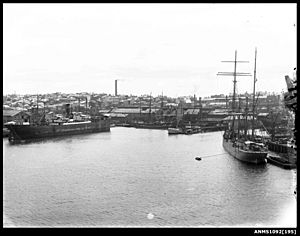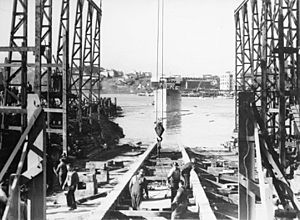Mort's Dock facts for kids
Quick facts for kids Mort's Dock |
|
|---|---|

Vessels at Mort's Dock, Sydney Harbour, 1908
|
|
| Location | Thames, Mort, College, McKell, Cameron, Yeend Streets, Balmain, New South Wales, Australia |
| Built | 1853–1867 |
| Architect | Thomas Sutcliffe Mort (originally) |
| Official name: Mort's Dock; Mort's Dock & Engineering Company; Mort Bay Park | |
| Type | state heritage (archaeological-maritime) |
| Designated | 14 January 2011 |
| Reference no. | 1854 |
| Type | Boat Building |
| Category | Maritime Industry |
| Builders | Private labour |
| Lua error in Module:Location_map at line 420: attempt to index field 'wikibase' (a nil value). | |
Mort's Dock was a very important place in Balmain, New South Wales, Australia. It was a dry dock (where ships are repaired out of the water), a slipway (where ships are launched or pulled ashore), and a shipyard (where ships are built). It was the first dry dock ever built in Australia! It opened in 1855 and worked for over 100 years, closing in 1959. Today, this historic spot is a park.
Contents
History of Mort's Dock
How Mort Bay Became a Shipyard
Mort Bay was once called Waterview Bay. A small stream flowed from Balmain Hill into the bay. This stream had waterholes, named "Curtis Waterholes" after the owner, James Curtis.
In 1842, James Reynolds bought land there. He built a house and dammed the stream. He sold fresh water to ships in the bay.
Later, in 1853, Captain Thomas Rowntree bought the land. He saw it was perfect for a patent slip, which helps repair ships. To get money, Rowntree sold his ship, the "Lizzie Webber." He met Thomas Sutcliffe Mort, an auctioneer, during this sale.
Mort realized that Sydney needed places to fix ships. At that time, there were no such places south of Bombay, India. So, the location was ideal for a new business.
Thomas Sutcliffe Mort: The Visionary
Thomas Sutcliffe Mort was a very clever businessman. He was born in England and came to Sydney in 1838. He quickly became successful in selling wool and land.
By 1850, Mort was Sydney's top auctioneer. He made a lot of money from buying and selling land. He needed more port space for his wool ships. Building a dry dock here helped him create a building boom.
Sydney's First Dry Dock Opens
Mort's Dock was the idea of Thomas Sutcliffe Mort and Captain T. S. Rowntree. In 1853, steamships first arrived in Sydney Harbour. But there were no places to fix these new ships.
In 1854, Mort and Rowntree bought land at Waterview Bay. They dug out a large dry dock. It was about 123 meters long and 15 meters wide.
They formed the Waterview Bay Dry Dock Company in 1853. This company later became Mort's Dock & Engineering Company. They built Australia's first dry dock and a patent slip. Mort even offered workers a piece of land if they helped finish the dock.
The dock started working in March 1855. This was a year before the Fitzroy Dock on Cockatoo Island. The first ship repaired at Mort's Dock was the SS Hunter. This ship carried mail between Sydney and Newcastle.
As the dock grew, Mort sold more land around it. This helped pay for new additions in 1866 and 1875. By 1877, many working-class families lived in the area.
Growing into a Major Engineering Hub
At first, the dock was not as profitable as expected. By 1861, Mort and Rowntree leased out much of the land. It was used for storing cargo, small engineering jobs, and making metal parts.
In 1867, Mort's Dock became mainly an engineering company. They built steam locomotives, ship parts, mining equipment, and steel pipes. Mort ended his partnership with Rowntree. He took on Thomas McArthur as a new partner.
The company became the biggest private employer in the colony. It was also important for the union movement. The Australian Labor Party started here in 1891. This was thanks to Balmain Unionists.
By 1870, the dock built Australia's first locally made locomotive. In 1901, they opened a second dry dock, Woolwich Dock. By 1917, they had built 39 steamships and seven Manly ferries. They also made parts for Sydney's water system and the Sydney General Post Office.
World War II brought a lot of work to Mort's Dock. The Royal Australian Navy needed many new ships. Between 1940 and 1945, Mort's Dock built 14 of the 60 Bathurst-class corvettes. They also built four of the twelve River-class frigates. By the end of the war, Mort's Dock was second only to Cockatoo Island Dockyard in building naval ships.
After the war, shipbuilding slowed down. Other businesses moved away from Balmain. The biggest change came with container shipping in the 1960s. Mort's Dock closed in 1958. The company went out of business in 1959.
In 1960, Australian National Line (ANL) bought the site. The old dock was filled in and the buildings were taken down. It became a place to store containers for ships. This filling-in helped preserve the old dry dock and other parts underground.
People in the area wanted the site to be a park. Groups like the Balmain Association worked hard for this. In 1986, the government agreed to build some housing and a park. The park was finished in stages between 1985 and 1989. The container terminal closed in 1989. The remaining parts of Mort's Dock were protected as heritage in the same year. The nearby Dry Dock Hotel reminds people of the old dock.
Mort's Dock Timeline
Here are some key changes to the site over time:
- 1853: Construction of the dry dock began.
- 1854: A stone office building was built.
- 1855: The dry dock was completed.
- 1866: Engineering and blacksmith works expanded.
- 1870: A dam was built at one end of the dry dock.
- 1874: The dry dock was made longer, to 390 feet.
- 1868: The first patent slipway was built.
- 1898: The dry dock was extended again, to 640 feet.
- 1959: The company closed down and was sold to Sims Metal.
- 1963: ANL bought part of the site for a container facility.
- 1966: ANL added a second shipping berth.
- 1967: Sims Metal tore down buildings on the northern side of the dry dock.
- 1968–1969: ANL filled in the dry dock. They leveled the site and covered it with bitumen. It was used as a container depot until 1975.
- 1980: The NSW Government suggested making about 7 hectares of the site into a park and housing.
- 1985: Park development started with demolishing old buildings.
- 1986: The first part of the park was finished. The second stage began.
- 1989: The second stage of the park was completed.
What Remains Today
The old dry dock and other parts of the site are still buried under Mort Bay Park. You can see the top of the stone walls of the dry dock in the park. Parts like the caisson (a watertight gate), stone walls, and ship bollards (posts for tying ropes) are still there. Remnants of the patent slips and later container wharf also remain.
Experts believe the site has a lot of potential for archaeological study. It is very well preserved because it was filled in during the 1960s.
Why Mort's Dock is Important (Heritage Listing)
Mort's Dock was the biggest shipyard and engineering workshop in Australia in the late 1800s. It helped Sydney become a major port for ships. The buried remains of the dry dock are very rare.
Mort's Dock was added to the New South Wales State Heritage Register on January 14, 2011. This means it is a very important historical site.
Here's why it's important:
- It shows how history unfolded in New South Wales.
It was a key industrial site for the state. It was Sydney's first dry dock and worked for many years.
- It is linked to important people.
It has a connection to Thomas Rowntree and Thomas Sutcliffe Mort. Also, John Storey (who became Premier of NSW) and William McKell (who became Governor-General of Australia) both learned their skills here.
- It shows great technical skill.
The site is a unique landmark. It represents a big technical achievement as the first dry dock in the colony. It opened a year before the one on Cockatoo Island. The site also helped develop new ideas, like refrigerated transport for ships.
- It has a strong connection to the community.
Mort's Dock is important socially and culturally. It helped Balmain become a working-class area. It was also where the Ship Painters and Dockers Union started in 1872. The Australian Labor Party was also formed here in 1891.
- It can teach us more about history.
The site can provide scientific and archaeological information. This helps us understand NSW's cultural, industrial, and maritime history. The buried structures are very well preserved. Mort's Dock is a key site for learning about past shipbuilding and engineering.
- It is rare and special.
It is one of only a few surviving dry docks of its kind in Australia. It shows an old way of life and work in NSW. It provides clear evidence of past shipbuilding and manufacturing.
- It represents a type of important place.
The site shows what shipbuilding, ship repair, and engineering works were like back then. It represents the growth of the colony and Australia as a maritime nation. During World War II, Mort's Dock built many important naval ships. This was crucial for Australia's war effort.
See also
- Wagon Mound (No 1)
- Poole & Steel, which also had facilities located in Balmain
- Fitzroy Dock, another mid-19th century dry dock on Sydney Harbour
- Sutherland Dock, a late 19th century dry dock on Sydney Harbour
- Woolwich Dock, an early 20th century dry dock on Sydney Harbour





